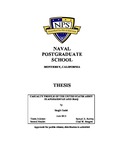Casualty Profile of the United States Army in Afghanistan and Iraq

Download
Author
Ozcan, Sezgin
Date
2012-06Advisor
Buttrey, Samuel E.
Second Reader
Seagren, Chad W.
Metadata
Show full item recordAbstract
The purpose of this study is to create a profile of U.S. Army troops killed or injured due to hostile incidents in Afghanistan and Iraq between 2003 and 2011. The file used in this study was obtained from the Defense Manpower Data Center (DMDC). It was built from active-duty personnel extract files, covering the period from 2003 to 2011. Our study shows that pay grades E1 through E3 are more likely to be involved in hostile incidents than other pay-grade groups, and that probability of injury or death decreases as pay grade increases. The findings for gender are not parallel to popular ideas. Male servicemen are less likely to get killed or injured than women after adjusting for other casualties. In terms of the effects of marital status, our study shows that married servicemen are more likely to be involved in hostile incidents. In our model, we found that regular forces have a lower risk of engaging in hostile incidents than guard and reserve forces, which is contrary to general expectation. The results for MOS were as expected. Combat troops are more likely to be killed or injured than other troops. As a conclusion for our multivariate model, a serviceman who is female, married, serving in the reserve forces, serving in a combat troop, between pay grades E1E3, serving in Iraq, serving the first deployment is the serviceman with most potential to get injured or killed in the U.S. Army.
Collections
Related items
Showing items related by title, author, creator and subject.
-
Saving lives and money two wheels at a time
Lake, Kavan O. (Monterey, California. Naval Postgraduate School, 2010-03);In fiscal year 2008, motorcycle fatalities in the Navy and Marine Corps totaled more than combat fatalities for Sailors and Marines in both Iraq and Afghanistan. This study examines how motorcycle accidents and motorcycle ... -
WHEN GREEN AND BLUE COLLIDE: THE RELATIVE SUPERIORITY THEORY AND LAW ENFORCEMENT INCIDENTS
Lenart, Harley J. (Monterey, CA; Naval Postgraduate School, 2019-09);The past three decades have seen a significant increase in suspects using weapons, which had not been readily available to the public, and which are more lethal. When suspects are better armed and more skilled with their ... -
Explosive Remnants of War:The Problem; Strategic Insights: v.2, issue 4 (April 2003)
Hunger, Roman (Monterey, California. Naval Postgraduate School, 2003-04);US troops who were engaged in eastern Afghanistan to search out and destroy the caves used by Al-Qaeda and Taliban forces described the area as being littered with US cluster bombs and unexploded ordnance, which caused ...


 12Jun_Ozcan.pdf (814.3Kb)
12Jun_Ozcan.pdf (814.3Kb)

